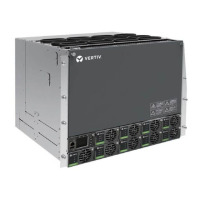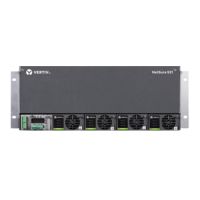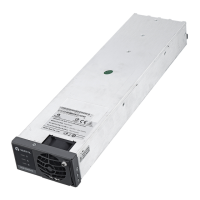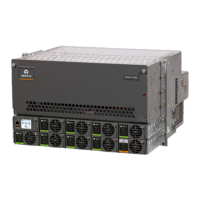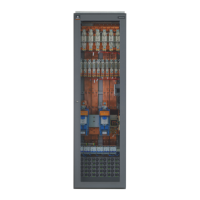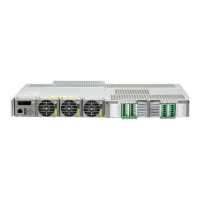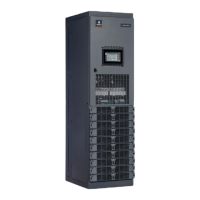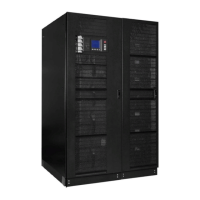Vertiv™ NetSure™ V200E50 DC Power Retrofit Installation and User Manual
Proprietary and Confidential © 2022 Vertiv Group Corp.
2. Backup: If rectifier output voltage exceeds a second (non-adjustable) value, the rectifier shuts down and locks out
regardless of load. Manual restart is then required. The backup HVSD setpoint is 59.5V (within the range of 58.5 to
60V).
Load Sharing (via system MCA): The MCA load sharing feature automatically balances the load to within ±2% of the rectifier’s rated
output current. If the MCA's load sharing feature is disabled for any reason, advanced digital active load sharing technology in each
Rectifier balances the load. The MCA's load sharing feature is disabled whenever the system is in current limit, the system is
delivering more than 97% capacity, or the system is delivering less than 3% capacity.
NOTE!
For optimal load sharing between the V200 Retrofits and legacy V200 PCUs, MCA version 4.2.0 or newer is required.
With earlier MCA versions, system functionality is maintained; however, load sharing will not be proportional.
Startup Time: Each rectifier has two startup modes:
a) Normal Soft Start Time: The duration from the time when the Rectifier is powered on to the time when the Rectifier provides
output voltage is <8s.
b) Current Walk-In: The rise time of the Rectifier output voltage is >8s at 90% of the rated load, and the maximum time is 90s at
100% of the rated load.
Hot Swappable: Each rectifier is designed to be plug-and-play. The rectifier can be inserted or removed from a live DC power system
with no damage. When the rectifier is plugged into the system, the system output voltage will not be affected.
NOTE!
The Retrofit Mounting Frame CANNOT be installed in or removed from the Power Bay unless all Rectifiers are first
removed from the Mounting Frame. Doing so will defeat the precharge circuit in the rectifiers and cause arching and pitting
on the DC power connector!
Cooling: Each rectifier contains two fans for front-to-back forced convection cooling.
Fan Control: When the PFC bus voltage is within a normal range, the built-in processor adjusts the fan’s speed according to the
Rectifier’s internal temperature and output current. For example, a higher temperature or output current will increase the fan speed.
Above 45°C at full load, the fan operates at full speed. When the PFC bus voltage is abnormal, such as very low bus voltage, the fan
turns off.
Fan Fault Protection: An alarm will be generated upon a fan fault. In such cases, the fault indicator (red) on the Rectifier front panel
will flash and the Rectifier will also inhibit its output. Auto-recovery is enabled upon the clearing of the corresponding fault.
Communication Failure: A rectifier’s protection indicator (yellow) will begin flashing should it experience a communication failure.
The failure information will be reported to the Controller and the Controller will process the failure accordingly. During a
communication failure, in order to protect the battery, rectifier output voltage will automatically adjusted to a default value of 53.5 V.
The rectifier will revert to normal operation once normal communication is restored.
Imbalance of Rectifier Output Current: When the output current of a rectifier in a DC power system is unbalanced, the rectifier having
the unbalanced output current will be identified automatically and its protection indicator (yellow) will illuminate.
The failure information will be reported to the Controller and the Controller will process the failure accordingly.
Paralleling: A Power System equipped with V200 Retrofits may be connected in parallel with any rectifier of the same polarity and
adjusted to the same output voltage.
Emergency Shutdown and Fire Alarm Disconnect: The rectifiers can be inhibited by application of an external ground signal to the
system. Manual restart is required. This option is selectable on the bays only and not the retrofit shelf.
NOTE!
The cooling fans will continue to operate if AC input voltage is present.

